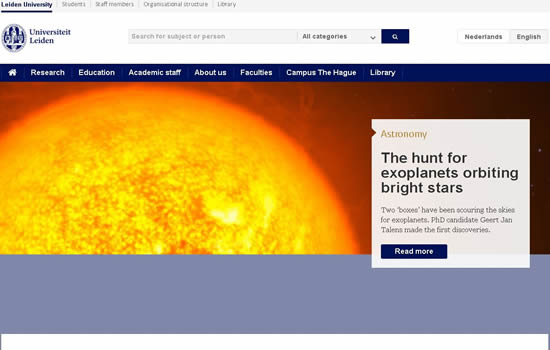选择热点
 荷兰莱顿大学
荷兰莱顿大学 西班牙巴塞罗那大学
西班牙巴塞罗那大学 巴西圣保罗大学 University of Sao Paulo, Brazil
巴西圣保罗大学 University of Sao Paulo, Brazil 台湾南华大学 University of South China in Taiwan
台湾南华大学 University of South China in Taiwan 科技大学 National University of Defense Technology
科技大学 National University of Defense Technology 南京大学 Nanjing University
南京大学 Nanjing University 上海复旦大学 Fudan University
上海复旦大学 Fudan University 泗水大学(Ubaya)
泗水大学(Ubaya) 印尼大学 universitas indonesia
印尼大学 universitas indonesia 越南某大学 Vietnam National University
越南某大学 Vietnam National University 菲律宾大学 University Of The Philippines
菲律宾大学 University Of The Philippines
形容词位置的前置与后置
发布时间:2025-01-06
来源:大学网站
形容词位置的前置与后置1.
形容词用作定语一般应前置(即置于被修饰的名词前):old people 老人 beautiful houses 漂亮的房子a tall buildings 高楼 an interesting film 有趣的电影2.
以下情况形容词作定语可以后置或必须后置:① 表语形容词若用作定语,必须后置。
如:Who is the greatest poet alive?
谁是当今世界上最伟大的诗人?
② 修饰something, anything, everything, nothing, everyone, anybody 等复合不定代词的形容词,必须后置。
如:There is nothing wrong with it.
这没什么问题。
Anyone intelligent can do the work.
任何有头脑的人都能做这事。
③ 若不是单个的形容词,而是一个形容词短语用作定语,必须后置。
如:Dig a hole large enough for the tree.
挖一个大洞,要能种下这棵树。
I know an actor suitable for the part.
我认识一个适合扮演这个角色的演员。
④ 某些特殊表达:court martial 军事法庭,Poet Laureate 桂冠诗人,等。
⑤在“数词+名词+old (long, high, deep, tall等)”结构中,形容词总是后置。
如:Her husband is 55 years old.
她丈夫55岁。
The well is 25 meters deep.
这口井25米深。
注:形容词heavy不用于该结构,如回答How heavy is the box?
时,不能用It’s 10 kilos heavy.
(应去掉heavy)⑥ 成对的形容用作定语,可以后置:There was a huge cupboard, simple and beautiful.
有一个大食柜,简朴而美观。
3.
少数形容词用作定语时可前置也可后置,且意义差不多:① last, next, following, preceding, past 等修饰表时间的名词通常前置,但也可后置(注意表达上的变化):next Monday / on Monday next 下周星期一last month / in the month last 上个月the following month / in the month following 下个月② 形容词enough, opposite等修饰名词时可前置或后置。
如:We have enough time [time enough] 我们有足够的时间。
He lives in the house opposite [the opposite house].
他住在对面的房子里。
在现代英语中enough 通常放在被修饰名词之前,若置于被修饰名词之后,则被认为带有古义或文学味。
③ 有的形容词前置和后置均可,但含义不同。
如:I know none of the members present.
在场的成员我一个也不认识。
(present=在场的)I know none of the present members.
现在的成员我一个也不认识。
(present=现在的)有些既可用作形容词又可用作副词的词,当它用作形容词时前置,用作副词时后置。
如:upstairs rooms / rooms upstairs 楼上的房间而有些既可用作形容词又可用作副词的词,它虽可前置和后置,但含义不同。
如:overseas students 外国留学生(指外国到本国来求学的学生,等于students from overseas)students overseas 出国留学生(指本国到外国去求学的学生,等于students who are overseas)【形容词位置的前置与后置查看网站:[db:时间]】
形容词用作定语一般应前置(即置于被修饰的名词前):old people 老人 beautiful houses 漂亮的房子a tall buildings 高楼 an interesting film 有趣的电影2.
以下情况形容词作定语可以后置或必须后置:① 表语形容词若用作定语,必须后置。
如:Who is the greatest poet alive?
谁是当今世界上最伟大的诗人?
② 修饰something, anything, everything, nothing, everyone, anybody 等复合不定代词的形容词,必须后置。
如:There is nothing wrong with it.
这没什么问题。
Anyone intelligent can do the work.
任何有头脑的人都能做这事。
③ 若不是单个的形容词,而是一个形容词短语用作定语,必须后置。
如:Dig a hole large enough for the tree.
挖一个大洞,要能种下这棵树。
I know an actor suitable for the part.
我认识一个适合扮演这个角色的演员。
④ 某些特殊表达:court martial 军事法庭,Poet Laureate 桂冠诗人,等。
⑤在“数词+名词+old (long, high, deep, tall等)”结构中,形容词总是后置。
如:Her husband is 55 years old.
她丈夫55岁。
The well is 25 meters deep.
这口井25米深。
注:形容词heavy不用于该结构,如回答How heavy is the box?
时,不能用It’s 10 kilos heavy.
(应去掉heavy)⑥ 成对的形容用作定语,可以后置:There was a huge cupboard, simple and beautiful.
有一个大食柜,简朴而美观。
3.
少数形容词用作定语时可前置也可后置,且意义差不多:① last, next, following, preceding, past 等修饰表时间的名词通常前置,但也可后置(注意表达上的变化):next Monday / on Monday next 下周星期一last month / in the month last 上个月the following month / in the month following 下个月② 形容词enough, opposite等修饰名词时可前置或后置。
如:We have enough time [time enough] 我们有足够的时间。
He lives in the house opposite [the opposite house].
他住在对面的房子里。
在现代英语中enough 通常放在被修饰名词之前,若置于被修饰名词之后,则被认为带有古义或文学味。
③ 有的形容词前置和后置均可,但含义不同。
如:I know none of the members present.
在场的成员我一个也不认识。
(present=在场的)I know none of the present members.
现在的成员我一个也不认识。
(present=现在的)有些既可用作形容词又可用作副词的词,当它用作形容词时前置,用作副词时后置。
如:upstairs rooms / rooms upstairs 楼上的房间而有些既可用作形容词又可用作副词的词,它虽可前置和后置,但含义不同。
如:overseas students 外国留学生(指外国到本国来求学的学生,等于students from overseas)students overseas 出国留学生(指本国到外国去求学的学生,等于students who are overseas)【形容词位置的前置与后置查看网站:[db:时间]】
相关阅读
目录列表
资讯列表
英语资讯


共0条评论
网友评论温馨提示:您的评论需要经过审核才能显示,请文明发言!